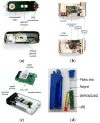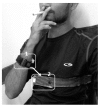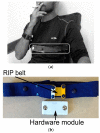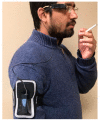Wearable Sensors for Monitoring of Cigarette Smoking in Free-Living: A Systematic Review
- PMID: 31661856
- PMCID: PMC6864810
- DOI: 10.3390/s19214678
Wearable Sensors for Monitoring of Cigarette Smoking in Free-Living: A Systematic Review
Abstract
Globally, cigarette smoking is widespread among all ages, and smokers struggle to quit. The design of effective cessation interventions requires an accurate and objective assessment of smoking frequency and smoke exposure metrics. Recently, wearable devices have emerged as a means of assessing cigarette use. However, wearable technologies have inherent limitations, and their sensor responses are often influenced by wearers' behavior, motion and environmental factors. This paper presents a systematic review of current and forthcoming wearable technologies, with a focus on sensing elements, body placement, detection accuracy, underlying algorithms and applications. Full-texts of 86 scientific articles were reviewed in accordance with the Preferred Reporting Items for Systematic Review and Meta-Analyses (PRISMA) guidelines to address three research questions oriented to cigarette smoking, in order to: (1) Investigate the behavioral and physiological manifestations of cigarette smoking targeted by wearable sensors for smoking detection; (2) explore sensor modalities employed for detecting these manifestations; (3) evaluate underlying signal processing and pattern recognition methodologies and key performance metrics. The review identified five specific smoking manifestations targeted by sensors. The results suggested that no system reached 100% accuracy in the detection or evaluation of smoking-related features. Also, the testing of these sensors was mostly limited to laboratory settings. For a realistic evaluation of accuracy metrics, wearable devices require thorough testing under free-living conditions.
Keywords: ECG; IMU; RIP; cigarette smoking; respiration; signal processing; smoke exposure; wearable sensor.
Conflict of interest statement
Authors declare no financial conflict of interest. The content is solely the responsibility of the authors and does not necessarily represent official views of NIH.
Figures








Similar articles
-
Wearable Egocentric Camera as a Monitoring Tool of Free-Living Cigarette Smoking: A Feasibility Study.Nicotine Tob Res. 2020 Oct 8;22(10):1883-1890. doi: 10.1093/ntr/ntz208. Nicotine Tob Res. 2020. PMID: 31693162 Free PMC article.
-
Sensors for Smoking Detection in Epidemiological Research: Scoping Review.JMIR Mhealth Uhealth. 2024 Oct 30;12:e52383. doi: 10.2196/52383. JMIR Mhealth Uhealth. 2024. PMID: 39476379 Free PMC article.
-
Development of a Multisensory Wearable System for Monitoring Cigarette Smoking Behavior in Free-Living Conditions.Electronics (Basel). 2017 Dec;6(4):104. doi: 10.3390/electronics6040104. Epub 2017 Nov 28. Electronics (Basel). 2017. PMID: 29607211 Free PMC article.
-
Objective Detection of Cigarette Smoking from Physiological Sensor Signals.Annu Int Conf IEEE Eng Med Biol Soc. 2019 Jul;2019:3563-3566. doi: 10.1109/EMBC.2019.8856831. Annu Int Conf IEEE Eng Med Biol Soc. 2019. PMID: 31946648
-
The Potential of Wearable Sensors for Detecting Cognitive Rumination: A Scoping Review.Sensors (Basel). 2025 Jan 23;25(3):654. doi: 10.3390/s25030654. Sensors (Basel). 2025. PMID: 39943293 Free PMC article.
Cited by
-
Considerations for remote delivery of behavioral economic interventions for substance use disorder during COVID-19 and beyond.J Subst Abuse Treat. 2021 Jan;120:108150. doi: 10.1016/j.jsat.2020.108150. Epub 2020 Oct 4. J Subst Abuse Treat. 2021. PMID: 33298296 Free PMC article.
-
Acceptability of smokers of a conceptual cigarette tracker as wearable for smoking reduction.BMC Res Notes. 2022 Feb 10;15(1):38. doi: 10.1186/s13104-022-05935-2. BMC Res Notes. 2022. PMID: 35144671 Free PMC article.
-
A Determination Method for Gait Event Based on Acceleration Sensors.Sensors (Basel). 2019 Dec 12;19(24):5499. doi: 10.3390/s19245499. Sensors (Basel). 2019. PMID: 31842502 Free PMC article.
-
An Update on the Use of Wearable Devices in Men's Health.World J Mens Health. 2023 Oct;41(4):785-795. doi: 10.5534/wjmh.220205. Epub 2023 Jan 27. World J Mens Health. 2023. PMID: 36792091 Free PMC article. Review.
-
Wearable Sensors for the Monitoring of Maternal Health-A Systematic Review.Sensors (Basel). 2023 Feb 22;23(5):2411. doi: 10.3390/s23052411. Sensors (Basel). 2023. PMID: 36904615 Free PMC article.
References
-
- WHO . International Classification of Diseases, 11th revision (ICD-11) WHO; Geneva, Switzerland: 2018. [(accessed on 8 July 2018)]. Available online: http://www.who.int/classifications/icd/en/
-
- American Cancer Society Harmful Chemicals in Tobacco Products. [(accessed on 8 July 2018)]; Available online: https://www.cancer.org/cancer/cancer-causes/tobacco-and-cancer/carcinoge....
-
- National Cancer Institute Harms of Cigarette Smoking and Health Benefits of Quitting. [(accessed on 8 July 2018)]; Available online: https://www.cancer.gov/about-cancer/causes-prevention/risk/tobacco/cessa....
-
- C. O. on S. and Health Smoking and Tobacco Use; Surgeon General’s Reports. [(accessed on 8 July 2018)];2004 Available online: http://www.cdc.gov/tobacco/data_statistics/sgr/2004/
-
- What Happens to Your Body When You Smoke? [(accessed on 8 July 2018)];Mercola.com. Available online: http://articles.mercola.com/smoking-side-effects.aspx.
Publication types
MeSH terms
Grants and funding
LinkOut - more resources
Full Text Sources
Miscellaneous

